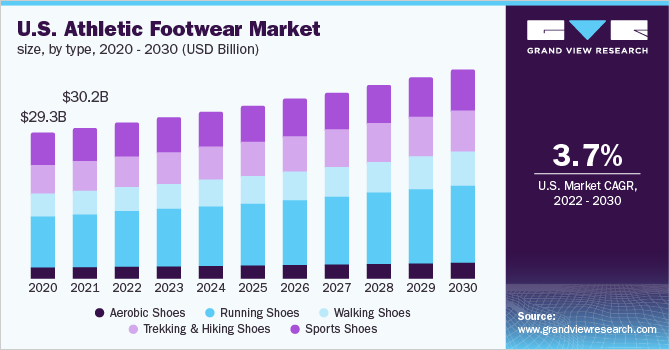Athletic Footwear Industry Overview
The global athletic footwear market size is expected to reach USD 196.1 billion by 2030, according to a new report by Grand View Research, Inc. It is expected to expand at a CAGR of 4.9% from 2022 to 2030. Athletic shoes have also been tailored for the casual market, and are popular, especially with young people. Athletic footwear is built for high performance and is considered a part of an athlete’s gear along with clothing and equipment. Athletic shoes provide sports-specific levels of cushioning, flexibility, stability, traction, and durability. Cushioning minimizes the force of impact.

Increasing awareness regarding the health benefits of sports and fitness activities that helps to reduce the risks of various illnesses, such as obesity, depression, and diabetes, is expected to fuel the growth of the market. Moreover, changing consumer lifestyles, a rise in the disposable income of consumers, and the growing retail e-commerce sector worldwide are some other factors expected to boost the market growth during the forecast period.
Athletic Footwear Market Segmentation
Grand View Research has segmented the global athletic footwear market on the basis of type, end user, and region:
Based on the Type Insights, the market is segmented into Aerobic Shoes, Running Shoes, Walking Shoes, Trekking & Hiking Shoes, and Sports Shoes
- The running shoe segment dominated the market in 2021 with a revenue share of over 35.0%, which can be attributed to the daily usage of running shoes and the availability of these shoes in a wide range of prices ranging from affordable athletic shoes to highly luxurious athletic shoes.
- The sports shoe segment has been further reviewed based on prominent sports in each of the regions.
- The trekking and hiking shoe segment is anticipated to exhibit a healthy growth rate during the forecast period owing to technological advancements that have ensured more comfort and flexibility for hikers.
Based on the End-user Insights, the market is segmented into Men, Women, and Children
- The men's segment held the largest revenue share of over 55.0% in 2021. The segment will continue to dominate the market until 2030.
- Women’s footwear is catching up gradually as the popularity of sports continues to grow among women, particularly in markets previously unexplored.
- In addition, the overall level of awareness regarding fitness among women is considerably high in advanced countries as compared to developing countries.
- However, the scenario is changing gradually in developing countries in line with efforts being carried out by respective countries’ governments to encourage women to participate actively in sports and other fitness-related activities. This is likely to boost the sales of women’s athletic footwear considerably in emerging markets.
Athletic Footwear Regional Outlook
- North America
- Europe
- Asia Pacific
- Central & South America
- Middle East & Africa (MEA)
Key Companies Profile & Market Share Insights
The market includes both international and domestic participants. Key market players focus on strategies such as innovation and new product launches to enhance their portfolio offering in the market. In March 2021, a Kanye west inspired line of sneakers was launched by Adidas as the Yeezy series 450 as a sequel to Yeezy 350 series. In June 2021, Kiko Kostadinov’s ASICS GEL-Quantum Levitrack was launched, with a GEL midsole.
Some prominent players in the global Athletic Footwear market include:
- Adidas AG
- ASICS Corporation
- Fila Inc.
- Under Armour, Inc.
- Lotto Sport Italia S.p.A
- New Balance Athletics, Inc.
- Vans, Inc.
- Nike, Inc.
- Puma SE
- Reebok International Ltd.
Order a free sample PDF of the Athletic Footwear Market Intelligence Study, published by Grand View Research.


No comments:
Post a Comment